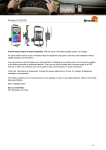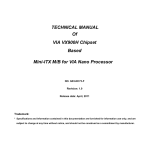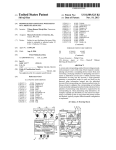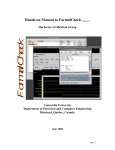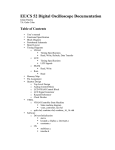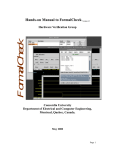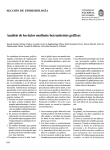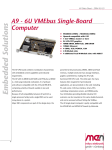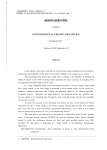Download In an induction balance transmit/receive type
Transcript
United States Patent ‘[191 Shoemaker [11] [45] [54] METAL DETECTOR WITH CIRCUITS FOR AUTOMATICALLY SCREENING OUT THE EFFECTS OF OFFSET AND MINERALIZED [57] Donald K. Shoemaker, Sweet Home, Oreg. quadrature phase detectors, one of whose outputs is approximately in phase with the ground component of [21] Appl. No.: 844,797 [51] [52] [58] the loop return signal. That output is modi?ed, during ‘ Mar. 27, 1986 an air balance of the detector, to remove the residual offsets in the circuit. This modi?ed output in turn is summed with the other phase detector output to pro Int. Cl.4 ...................... .. G01V 3/11; GOlR 33/00 US. Cl. ............................ .. 324/329; 324/233 Field of Search .............................. .. 324/326-329, duce a phase detection signal that can be adjusted by automatic means to be precisely in quadrature with the ground component of the loop return signal. A control ler is provided, with selectable user inputs, to initiate the static and dynamic GEB operations. An error am~ 324/233 [56] References Cited U.S. PATENT DOCUMENTS 4,303,897 12/1981 Podhrasky ................... 4,387,338 4,470,015 ABSTRACT as the system is used. The circuit includes a pair of Home, Oreg. [22] Filed: Nov. 8, 1988 the user, continual automatic GEB on a dynamic basis [73] Assignee: White’s Electronics, Inc., Sweet - 4,783,630 A portable transmit/receive induction balance type metal detector having an automatic ground exclusion balance (GEB) feature to facilitate the screening out of the effects of mineralized ground. The circuitry pro vides a static GEB in a single try and then, if selected by GROUND [75] Inventor: Patent Number: Date of Patent: pli?er in conjunction with two sample/hold elements 324/324 and a variable duty cycle chopper operate in a feedback 6/1983 Hecht et al. .. .. 324/236 9/1984 Hirschi et al. .................... .. 324/233 loop to appropriately adjust the phase detection signal. Audible beep indications are generated to signal the Primary Examiner—Reinhard J. Eisenzopf user when the steps in the automatic GEB are com~ pleted. Assistant Examiner-Walter E. Snow Attorney, Agent, or Firm-Chemoff, Vilhauer, McClung & Stenzel 6 Claims, 15 Drawing Sheets LOOP RETURN 5mm. 5° Y amomss PEAuPuFsR mo PHASE amorous I00 x x OFFSET —- x ____+ CANCEL sAuPLE/Rom 5am H LOOP orrss'r\ mm“- 20 mscmac: CONTROL m VARIABLE nu'rv CYCLE scum: WAVE (6592"1) (IO vomaz-m DUTY-CYCLE Dc CONTROL xurr. osc. . mo muz/ LOOP omv: smEwAvE ) AUDIO 6592": new: scum: wsv: mama vomse I30 I k ' W G SUMMING MPUFTER GAIN STAGE CHOPPER I20 LAGES FEEDBACK PATH ‘55R CONTROL LOGIC US. Patent Nov. 8, 1988 Sheet 4 of 15 .M4U0E -.(0.6-. .G-n946 4,783,630 US. Patent Nov. 8, 1988 Sheet 5 0f 15 4,783,630 — bO VOU ~10m$_ 2-3.58 a“:3m3% 5.?3F # m W n. .3 h C>3524”; 5 _ pt lAowo-0eE 97m . F. [In .U-nr49_ US. Patent Nov. 8, 1988 Sheet 9 of 15 4,783,630 FIG. 3A5 .O2Hl30 D _.8 7DR79.R 4. w IaT LA“ M _C.WC 0:v. mo R3elmD ?B9L/¢T4.OT7\'7. B_.u RA56r0 REa1LC_* _ n "w .O _ mJ \ aI “a; m 4 m o W. TT K| I_2K5KF C T.IZEN.w..N.00 w“ 8mm + 5...35.4.L% B +2m M"K Run.» lM2+VH. IE4 vF v.94 a RM Ma. L8 M :v. #GIT aw.TWU 0l 03¢./ 5b (\ V7.* R5.C -PTOQ-I. m .h 4. M”: ua+1m Q.O .0_NO7.1+» Y 9.“RIMm MlR5Y Mm 2 5m cv‘.7 o Q .wc 17i4In. vWWW “1 0v LN.-.1R ’ :1CNl WWW RBFlME0IR3 um. .» K mm ax w... x bm L 80 w _M. 4.2m. swo.H W72|1 0 m “a 5:.L+ z5 3 6%MI.E CT'RO51r5+ P3 4:w M .Z. B4I _ w m M % N3MU 4U.» uI A IE M tTW“ 5N 7..KDL47 Hbl“I #5, v T .0 3 .I US. Patent Nov. 3, 1988 Sheet 10 of 15 4,783,630 IJ 2102 020 Dim Hm o0n20e at: 202 US. Patent Nov. 8, 1988 Sheet 12 0f 15 .09“0 :6120. 4,783,630 US. Patent Nov. 8, 1988 Sheet 13 0f15 I 4,783,630 US. Patent Nov. 8, 1988 . Sheet 15 01' 15 4,783,630 FIG. 3B3 + - 9 1/4 cums ‘ a |°_ 1/4 u1 , c 1 1.11324 I’ *6] 1/1 cums H 1""“—9< u‘ l D 10 12 I- + $1‘ '20 mull H - V6 :04 e9 7 I _ __ 9-1 BB 2 I0 ' I _ see 511mm arr-I I __ _ XQRE‘HRN 1-15 l cows; I L-—_____] L __ X B-OFFSET FIJJJST __X‘_______| I00 | 15 , -° um 1/3 | 1/4 cums US 1 n 13] 1F‘ 1 4,783,630 2 ment for search and ?nd activity, with the offset or‘ METAL DETECTOR WITH CIRCUITS FOR AUTOMATICALLY SCREENING OUT THE EFFECTS OF OFFSET AND MINERALIZED GROUND adjustment in the loop circuit required to screen out the ground mineralization effects provided automatically, and then have this screening in effect, without further ado, as he/she proceeds over an area even though the ground’s mineralization content might change dramati BACKGROUND OF THE INVENTION The present invention relates to an apparatus and cally. In an exemplary embodiment of the present invention an air balancing operation is performed by the instru ance in portable hand-held metal detectors of the induc l0 ment’s circuit, in response to operator switch actuation, tion balance transmit/receive type in popular use today while momentarily holding the unit with its search head for searching and ?nding metal objects lying on or up in the air and away from any metal objects. An audi buried just beneath the surface of the ground. Such ble beep tone signals the completion of this “air bal method for providing automated ground exclusion bal detectors are held by the operator and moved or swept ance” cycle. The operator then places the loop on or over the surface of the ground, and, when the detector 15 very near the ground and switches the instrument to the passes over a metal object, the disturbance of a mag “ground balance” cycle. The instrument’s control logic netic ?eld created in the area of the detector’s search circuit then proceeds to automatically make the neces loop, as generated by a transmit coil signal and moni tored by a receive coil, unbalances the coil loop circuit sary changes in the loop circuit parameters to accom plish ground effect elimination, and when this step is completed a second audible beep occurs, thus signaling and causes the detector to produce a visual or audible indication of the presence of the metal object. Such instruments have in recent years become quite sophisti cated in operation, suf?ciently so that, by responding not only to the amplitude of the magnetic ?eld distur bance but also to the shift in the phase angle of the that the instrument is ready for use. The user can then, if desired, empirically con?rm that the instrument is indeed ground balanced by listening for any change, in 25 received or target signal relative to the transmitted signal, an approximate indication can be provided by the detector as to the type of metal object located, e.g. either direction, in the threshhold tone as the loop is moved over the ground in an area free of targets. After this static GEB has been accomplished the operator can, if ‘desired, maintain the detector in ground balance automatically as he/she uses it. The instrument is pro the type of metal coin involved, penny, nickel, dime, 30 vided with a self-adjusting, or dynamic, ground balanc ing feature which, as the loop is swept over the ground, quarter, etc. However, before utilizing these detectors a tracking circuit operates, under operator switch selec to search for and locate metal objects it is ?rst necessary tion, to automatically incrementally adjust the loop’s to adjust the loop circuit to screen out the effects of the circuit parameters, as needed, to maintain the unit in mineralized ground in the area. The compensation or adjustments to the detector’s search head loop circuit 35 ground balance even as the mineralization content of the soil changes. The instrument, in the illustrative em for such earth effects, referred to herein as “ground bodiment herein described, is also provided with a sen exclusion balance” or, more simply, “GEB,” was com sitivity-adjustable knob setting to enable the user to monly carried out prior to the present invention by coins as opposed to aluminum pull-tabs, and even as to cut-and-try manual techniques in which the operator regulate the operation of the tracking circuit so that would ?rst reset the detector instrument in air to cancel 40 target objects within the instrument’s range will not all offsets and to set a low but discernible audio tone inadvertently be tuned out. In a preferred form of the level in the detector, and then hold it on or just above a invention the detector is additionally provided with a patch of ground known or believed to be free of metal user-selectable “preset” or factory ?xed setting on its objects. The change from air to ground typically would sensitivity control which enables a novice operator to cause either a marked decrease or increase in the audio 45 obtain satisfactory performance with the unit with a tone, and the operator would next respond by changing, minimum of fuss (however, an experienced user will through manipulation of a knob setting on the instru invariably desire to set his/her own level of sensitivity ment, the parameters of its detector circuitry to change in the instrument, particularly when searching unusual the tone level in the opposite direction. The operator would then repeat the reset step, again change the ground balance setting, and continue this sequence as many times as necessary until the change in tone level in going from air to ground, or back, was either eliminated terrain.) Selection of the preset setting on sensitivity locks out the sensitivity knob control and prevents the user from turning the sensitivity control up so much that the ground balance tracking circuit does not work properly. Use of the preset setting enables the instru or reduced to an acceptable minimum level. Such man ment to be used effectively after a short while, even ual GEB adjustment, as can readily be appreciated from 55 without performing the GEB steps referred to previ the foregoing description, was tedious and time-con ously, as sweeping of the detector back and forth over suming, and the procedure had to be repeated whenever the ground in searching will cause the tracking circuit the mineralization content of the ground changed ap to eventually, in about 30 to 50 sweeps (the number preciably as the operator worked over an area. SUMMARY OF THE INVENTION The present invention provides a control logic circuit means for automating this GEB operation, both staticly and dynamically, the latter referring to the GEB func tion being performed by the instrument on a continual, 65 automatic basis as the detector is used to search over an area. As a consequence the operator, using a metal detector with this feature, can quickly set the instru required being determined by the amount the instru ment is initially off-range from the GEB condition), bring the loop circuit into ground balance. In the track ing circuit provided in the automated GEB system of the present invention the adjustment in the detector circuit’s parameters is made on each sweep of the search head as it approaches the low point nearest to the ground. Thus, for best results, the operator should im plement the initial, or static, GEB with the loop resting on or very near the ground, and then search by sweep 3 4,783,630 4 the nearby environment. Targets coming within the ing the loop as close to the ground as possible. If condi tion of the ground changes as the operator moves about the area the tracking circuit will adjust the loop circuit to keep the instrument in ground balance at all times area of the transmit coil’s ?eld change the loop return signal produced in the receive coil’s windings which are connected to a Band Pass Preampli?er and Phase Quad rature Detectors 50. The Band-Pass Preampli?er por tion boosts and buffers the loop return signal and re ' without need for operator intervention. Other objectives, features and advantages of the in vention will be apparent upon consideration of the fol duces the gain for frequencies far from the Transmit lowing detailed description of the invention, taken in Oscillator’s frequency. The Phase Detectors are sub conjunction with the accompanying drawings. stantially identical and serve as a balanced demodulator BRIEF DESCRIPTION OF THE DRAWINGS FIG. 1 is a block diagram of an illustrative example of a metal detector of the induction balance transmit/ receive balance type, with no provision for an auto X and Y component quadrature phase detector system. The two respective outputs X and Y of the Phase De tectors are summed in GEB Summing Ampli?er 60 and output as a phase shift signal G which is a function of the amplitude of the loop return signal as well as of the 15 difference in phase between the respective transmit and matic ground exclusion balance feature. loop return signals. A GEB Control 65 enables the user, FIGS. 2A and 2B block diagram of the metal detec tor embodiment of FIG. 1 modi?ed to include an auto prior to the summing, to vary the gain of one of the matic ground exclusion balance feature in accordance with the present invention. quadrature signal components, exemplarily X, corre sponding to the ground component, while maintaining FIGS. SAG-3A7 and 3B0-3B3 are electrical sche matic diagrams of an exemplary circuit embodiment of the metal detector of FIG. 2 having the automatic ground exclusion balance feature of the present inven tion. FIGS. 3A0 and 3B0 are diagrams illustrating the 25 the gain of the other component at unity. These three phase signals, X, Y and G, are then passed through Filters and Gain Stages 70 and supplied to a Threshold Detector 80 which also includes Discriminater Circuits for responding to and generating as an output to the Speaker 40 an audio indication of the presence of target layout arrangement of the electrical schematic diagrams objects in the ?'eld of the search loop. Knob switch/set of FIGS. 3A1 to 3A7 and 3B1 to 3B3 respectively. ting controls 90 and 91 are provided to enable the oper ator to vary, respectively, the degree of sensitivity of DETAILED DESCRIPTION OF THE the instrument and the degree of discrimination as be INVENTION 30 tween target objects of different response characteris tics. An illustrative embodiment of a metal detector of the The foregoing description is of a conventional metal described type having the automatic ground exclusion detector system circuitry in which GEB is effected by balance (AGEB) feature of the present invention is currently manufactured and marketed by applicant’s assignee, White’s Electronics, Inc., of Sweet Home, the user’s manual twiddling and adjustment of the GEB 35 Control setting 65 in the manner described earlier. FIGS. 2A and 2B depict the same simpli?ed metal detector system with the addition of the AGEB feature. (In this diagram elements labeled with the same refer Oreg., under the model name and trademark COIN MASTER 6000/Di Professional (hereinafter referred to as the “6000/Di Pro”). The operator’s manual for the 6000/DiPro instru ment, published by White’s Electronics, 1110., describes ence numerals are substantially the same as the similar 40 the manner in which the AGEB feature is utilized by the operator through panel switch settings and manipu ly-labeled elements in FIG. 1.) In providing AGEB, offsets in the loop circuit present in the X, or ground component, of the loop return signal, as derived by the Quadrature Phase Detectors 50, are cancelled out by lations of the instrument’s search head. While such description has been summarized earlier herein and is the X Offset Cancel 100 in response to an appropriate non-essential to an understanding of the nature and 45 actuating signal 102 from the Control Logic Module 110 when the user selects the “Air” position at 115. manner of operation of the present invention, it is useful in understanding its background and operational envi (Offsets refer to the residual DC levels in the output of the Phase Detectors.) The offset to the X component ronment. Accordingly, that publication, to the extent pertinent hereto in respect to the AGEB feature, is herein incorporated by this reference. signal is maintained by the Sample/Hold portion of this 50 element 100 until a subsequent time (to be described Referring ?rst to FIG. 1, there is shown a simpli?ed block diagram of a transmit/receive type induction balance metal detector, corresponding to the Model 6000/Di Pro, but without the AGEB feature included. The instrument comprises a Transmit Oscillator and Loop Drive 10 which causes a sinusoidal waveform to be produced in to the Search Loop 20 as well as provid ing an audio tone signal, supplied via Audio Output 30, to the Speaker 40 which provides an audible indication to the operator of the status of the loop’s balance circuit. The Audio Output 30 is preferably provided with a user-actuatable Sample/Hold circuit-~a conventional feature-~to allow offsets in the input to the audio stage to be cancelled. The Search Loop 20, as is conventional, comprises a pair of coils-a transmit coil driven by the 65 Transmit Oscillator which generates a magnetic ?eld in the area of the search loop and a receive coil which is responsive to changes in that magnetic ?eld caused by later) when a disable signal is supplied thereto from the Control Logic module via Discharge Control line 104. The Summing Ampli?er 60 determines the phase G of the loop return signal relative to the transmit signal by inversion summing of a ?xed multiple of the Y compo nent with a variable multiple of the X component. The adjustment a applied to the X component at the Sum ming Ampli?er is accomplished through the use of a Chopper 120 whose duty cycle, between zero and lOO%, is determined by the DC Control Voltage level 131 applied to Converter 130. The square wave signal 132 determines the frequency of the Converter’s output. In other words, the duration of the duty cycle, corre sponding to the adjustment on, is responsive to the out put 131 of the GEB Sample/Hold 170. In the air balance mode of operation the Error Am pli?er 150, through a feedback loop which is enabled by a control pulse 162 from the Control Logic module, ' 5 4,783,630 forces the output 164 of the Air Sample/Hold 160 to 6 An exemplary electrical schematic of the circuitry of the system, depicted in block diagram form in FIGS. 2A and 2B, is shown in FIGS. 3A1-3A7 and 3B1-3B3. Sections of the circuitry have been partitioned off by match the level of the G signal supplied from the Sum ming Ampli?er 60. A beep indication, signifying com pletion of the air balance step, is provided by the Audio Drive 30 upon the enabling of the feedback loop in dashed lines and labeled with reference numerals corre response to a pulse on the reset line 35 provided by the sponding to those of the corresponding elements in the Control Logic module. Output 164 is held until the block diagram of FIG. 2. Component elements in the schematic, and their respective values, are shown using standard industry nomenclature. ground balance step (described later) is completed. The Error Signal output 152 is provided as an input to GEB Sample/Hold 170 whose function is to provide the Control Voltage level 131. In the ground balance mode the Error Ampli?er, through an AGEB Feedback Path which is enabled by The terms and expressions which have been em ployed in the foregoing speci?cation are used therein as terms of description and not of limitation, and there is no intention, in the use of such terms and expressions, of control signals 171, 172 from the Control Logic mod ule, forces the output of the GEB Sample/Hold to match the G signal supplied from the Summing Ampli excluding equivalents of the features shown and de scribed or portions thereof, it being recognized that the scope of the invention is de?ned and limited only by the claims which follow. this matching accomplished, the G signal in ground What is claimed is: balance mode has been automatically modi?ed, through 1. In an induction balance transmit/receive type of adjustment of the X component signal, to equal the G 20 portable metal detector having an oscillator, a search signal level in air balance mode of the detector system. head with a transmit coil driven by said oscillator to This corresponds to the static balance operation de produce a magnetic ?eld and a receive coil producing as scribed earlier. When this step is completed the GEB an output a loop return signal responsive to changes in Sample/Hold 170 is caused to hold its output level 131 said magnetic ?eld caused by the nearby environment, a by the control signals 171, 172; at the same time the X 25 pair of phase detectors receiving said loop return signal Offset Cancel 100 is disabled by the control signal 104. ' and producing a pair of component signals in quadra An audio beep indication, signaling that this has oc ture, means for adding said component signals together curred, is provided by the Audio Drive 30 in response to produce a phase detection signal, and, indicator to a pulse on the reset line 35 provided by the Control means responsive to the amplitude of said phase detec ?er 60 to the output 164 of the Air Sample/Hold. With Logic module. 30 If it is desired that the system perform a dynamic ground exclusion balance as earlier described, then the user selects the “Gnd” position at 115, otherwise this feature is disabled. In the dynamic GEB setting a Slope Detector 180, responsive to the derivative of the X 35 component signal, provides a Ground Signal 182 whose polarity is indicative of the direction of the X compo nent’s slope. For example, a ?rst polarity signi?es the Search Loop 20 approaching the ground, and the other polarity, moving away or no movement relative to 40 ground. A change in that signal from the ?rst to the second polarity signi?es the point at which the search loop is closest to the ground. As the Search Loop moves away from ground or is static, as monitored by the Slope Detector, the Error Ampli?er 150 functions as when in the air balance mode to force the Air Sam? ple/Hold output 164 to match the Summing Ampli?er output G. When the Search Loop approaches the ground, the output 164 is held (as before), and in re sponse to a control signal from the Control Logic on the Slow Adjust line 172 the AGEB Feedback Path is closed and the DC Control Voltage 131 is adjusted (as described before) in response to the Error Signal 152 produced upon the matching of Summing Ampli?er tor signal, the improvement comprising: (a) air balance circuit means, responsive to said phase detector signal when said search head is held away and remote from the ground, for automatically adjusting said phase detection signal level so as to cancel out offsets occurring in said loop return signal; (b) static ground balance circuit means for screening out on a one-time, user-actuatable basis ground effects, said ground effects being the effects on said loop return signal of the mineralization content of the ground in the vicinity of said metal detector; (c) dynamic ground balance circuit means for screen ing out on a continuing, repetitive basis said ground effects; and (d) user-selectable switch means for transferring said metal detector being two modes of operation, the ?rst mode utilizing said air balance circuit means to adjust said phase detection signal to an air balance level of said detector, and the second mode utiliz ing said static and said dynamic ground balance circuit means to provide a screening out from said phase detection signal of said ground effects. 2. The metal detector of claim 1 including control means for varying the sensitivity of said detector in output G to the Air Sample/Hold output 164. In this 55 responding to the mineralization content of the ground dynamic GEB mode of operation a slow adjustment in the vicinity of said detector. rate, exemplarily about ten times the time constant of 3. The metal detector of claim 1 including means for the fast adjustment rate used in the static balance mode, providing an indication when said air balance circuit is utilized to limit the speed of the correction provided means has completed said adjustment. by the AGEB Feedback Path. This is preferably done, 60 4. The metal detector of claim 1 wherein said dy while in this mode, so as to minimize the error which would otherwise occur due to the presence of offsets in the X component signal. (During dynamic balance, it will be recalled, the X Offset Cancel 100 is disabled.) If namic ground balance circuit means has a circuit time constant which is at least an order of magnitude larger than the circuit time constant of said static ground bal ance circuit means so as to slow the response and the unit were left at a fast adjustment rate, for example 65 thereby avoid hunting in the operation of said dynamic a circuit time constant of one second as opposed to ten seconds, the circuit would hunt back and forth around the correct GEB setting. ground balance circuit means. ' 5. The metal detector of claim 1 wherein a ?rst indi cation is given when said metal detector has completed 7 4,783,630 8 responsive to both a change in the distance of said search head from the ground and the direction of said an air balance operation and a second indication is given when said metal detector has completed a static ground balance operation. change, said output signal being utilized in said dynamic 6. The metal detector of claim 1 characterized in that said dynamic ground balance circuit means includes slope detector means for producing an output signal ground balance circuit means for screening out said ground effects. * 1.0 15 20 25 35 45 50 55 60 65 * * 1K *




















